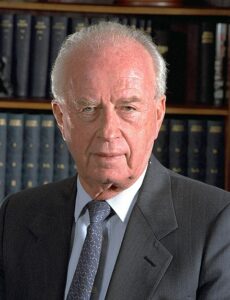
Yitzhak Rabin (March 1, 1922-Nov. 4, 1995) was born in Jerusalem to Nehemiah Rabin and his wife Rosa Cohen. His father, born Nehemiah Rubitzov, emigrated from Sudorovychi in present day Ukraine to the United States, and then came to Mandatory Palestine as a volunteer with the Jewish Legion. Rabin’s mother was an immigrant from Belarus, who was elected to the Tel Aviv City Council.
Rabin was enrolled at the School House for Workers’ Children in Tel Aviv, where he received good marks but his shyness masked his intelligence. At age 13, he enrolled at an agricultural school at Givat Hashlosha, a kibbutz his mother helped to found. A year later, in 1936, Rabin received military training from the Haganah. He then enrolled at Kadoorie Agricultural High School, where he received more military training under Yigal Allon, who later became a general in the IDF.
In 1941, Rabin joined a Palmach section of the Haganah that was under the command of Moshe Dayan. He participated in an Allied invasion of Lebanon, then controlled by Vichy France. It was the military campaign in which Dayan lost his eye. By 1943, Rabin had advanced to a platoon commander based at Kfar Giladi. In 1945, he planned a raid on the Atlit detainee camp at which his unit freed 208 Jewish immigrants who had been imprisoned by the British. Subsequently he was arrested and imprisoned for five months by the British. After his release, he became chief operations officer of the Palmach.
In Israel’s 1948 War of Independence he commanded the Harel Brigade, which fought its way to Jerusalem from the coastal plain. He also was in charge of the IDF unit that fired on the Altalena, a ship carrying weapons for the rival Irgun commanded by Menachem Begin before the two Jewish military forces were combined. Begin ordered his forces not to retaliate and later said in so doing he avoided an Israeli civil war.
Rabin was deputy commander of Operation Danny, which captured Ramle and Lydda, and from which, on Rabin’s orders, the inhabitants of Lydda were expelled. In 1949, he participated in the armistice talks with Egyptian negotiators on the island of Rhodes.
In 1956, Rabin headed Israel’s northern command, and in 1964, he was appointed by Prime Minister Levi Eshkol as the IDF chief of staff, a position he held in 1967 when the IDF won the 6-day war against the combined forces of Egypt, Syria, and Jordan, capturing Jerusalem, the West Bank, Gaza, and the Golan Heights.
In 1968, Rabin served as Israel’s ambassador to the United States, returning to Israel in 1973 where he was elected a member of the Knesset and was appointed Minister of Labor. After Golda Meir resigned as prime minister in the aftermath of the Yom Kippur War, Rabin became prime minister. During his term came the rescue operation of Israeli hostages held by Palestinian and German terrorists at the Entebbe airport in Uganda.
In 1977, Rabin resigned after it was disclosed that Rabin and his wife, the former Leah Schlossberg, still had bank accounts in Washington, D.C. — a violation of Israeli law. Afterwards, Rabin’s old foe, Menachem Begin of the Likud party, became prime minister, and Rabin’s rival, Shimon Peres, became the head of the Labor party. During the period between 1984 and 1990, Rabin served as Minister of Defense in unity governments headed by Yitzhak Shamir and Shimon Peres. He withdrew Israeli forces from the interior of Lebanon to a security zone on the Lebanese side of the Israel-Lebanon border. He pursued a tough “Iron Fist” policy against participants in the Intifada.
In 1992, Rabin unseated Peres as the Labor party leader, leading to his second term as prime minister. In 1993, Rabin and Palestine Liberation Organization Chairman Yasser Arafat exchanged letters of recognition, with Arafat renouncing violence. Encouraged by President Bill Clinton, Rabin had a historic handshake with Arafat at the White House in 1993. The following year, Rabin signed a peace treaty with Jordan. Along with Arafat and Peres, Rabin was awarded the 1994 Nobel Peace Prize, but the Oslo Accords were controversial in Israel. Yigal Amir, a right wing extremist, assassinated Rabin in 1995 at a peace rally held at Tel Aviv’s Kings of Israel Square, which later was renamed Rabin Square. An emergency cabinet meeting appointed Peres as his successor.
Tomorrow, March 2: Moe Berg
*
SDJW staff condensation of a Wikipedia article.